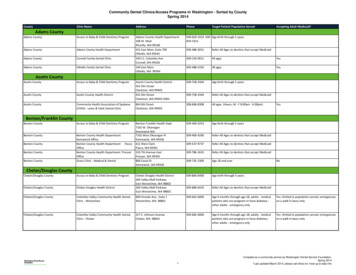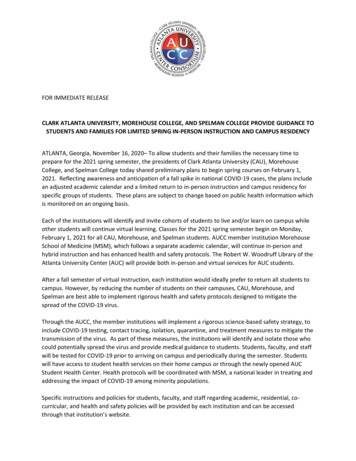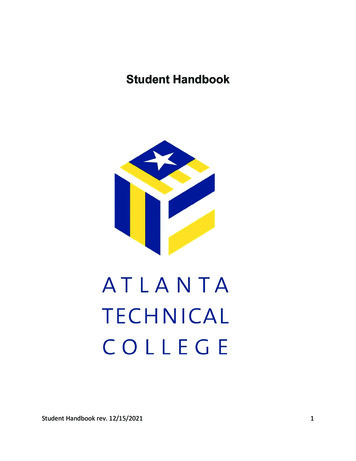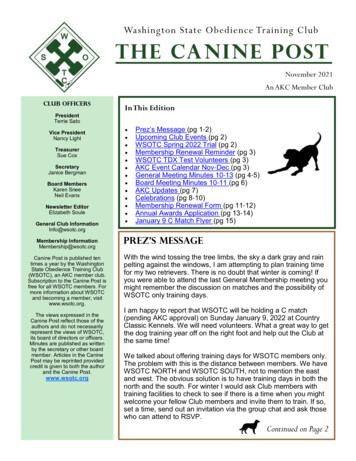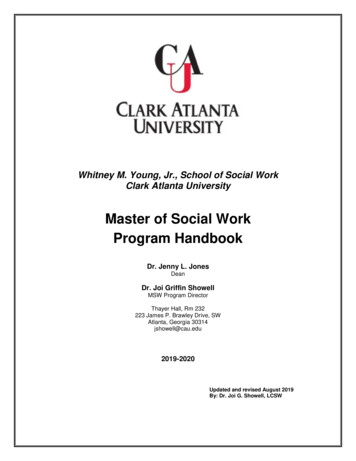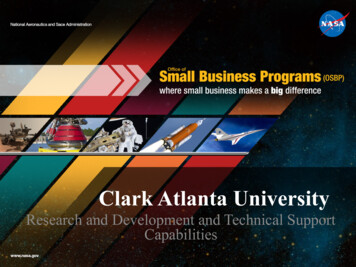
Transcription
Clark Atlanta UniversityResearch and Development and Technical SupportCapabilities
CAU Goals and Team Assemble a highly qualified Team to provide the government, its contractors, andsmall and large businesses with Research and Development and Technical SupportServices (R&DTSS). Deliver outstanding products and services. Develop residual technical capability and experience within CAU to respond tofuture contracts and to provide for the training and production of skilled minoritypersonnel to meet the nations science and engineering manpower needs for thefuture. The Team consists of highly qualified faculty, staff, and students and, if necessary,subcontractors that have a history of working with CAU faculty and students.Relevant Experience/Policies CAU and its subcontracts have experience with Task Order Contracts. CAU and its subcontractors have policies in place to protect Export Controlled Dataand abide to the International Trade Arms Regulations (ITAR). (Several Teammembers hold security clearances.) Examples of Past Performance are in our capabilities statement. DUNS No: 06-532-5177Cage Code: 0MVF5 NACIS ID(s): 611310, 541710, 541720SIC: 8221, 8732, 8733Federal EIN No: 58-1825259Certificates, Registrations, Accreditations: SACSCOC, AACSB, CSWE, CACREP, NSPPAA,NCATE, GAPSC
Clark Atlanta UniversityClark Atlanta University (CAU) is a private, urban, coeducational institution ofhigher education. The University was established in 1988 through theconsolidation of two parent institutions — Atlanta University (1865) and ClarkCollege (1869), the nation's first institution to award graduate degrees toAfrican Americans, and Clark College (1869) the nation's first four-year liberalarts college to serve a primarily African-American student population.
About CAU CAU is the largest of the 37 member UNCF colleges, offers undergraduate,graduate and professional, and non-degree certificate programs. CAU is classified by Carnegie as a Doctoral/Research University (DRU)and the only private, independent graduate research institution in theHBCU community, and the only HBCU member of the Georgia ResearchAlliance. CAU is accredited by the Southern Association of Colleges and SchoolsCommission on Colleges (SACSCOC) to award the baccalaureate, masters,specialist and doctorate degrees. The University offers 38 major areas of study through four schools – Artsand Sciences; Business Administration; Education; and Social Work andawards Bachelor’s, Master’s, Specialist, and Doctoral degrees. Total full-time teaching faculty number 171, 81% of whom hold terminaldegrees; 67% have tenure status. Faculty-student ratio is 1:15.
CAU STEM Degree Offerings BiologyB.S.M.S.PhD ChemistryB.S.M.S.PhD Computer andInformation Systems*B.S. Computer ScienceB.S.M.S. MathematicsB.S.M.S. PhysicsB.S.M.S. Dual-Degree Engineering (STEM B.S.Partner Institution)CAU/Engineering B.S.* Transforming to Department of Cyber-Physical Systems, which will includenew bachelor of science programs in cybersecurity, robotics, and dataanalytics.
CCRTD/ Biology Lab Capabilities Recombinant Protein ProductionSite directed mutagenesisCell sorting and stem cell technologyCancer Target discovery, drug development and evaluation (in vitro andin vivo)Developing genetically modified cell linesBioinformatics and large scale GWAS data analysisDNA, RNA and Protein analysisCell and organ cultureHistological analysis
Core Lab Equipment FACSTissue/ cell cultureHPLCImaging systems (Fluorescent, Luminescense,visible, UV)Microscopes (Confocal, Fluorescence, Live cellimaging, Laser capture Microdissection, whole slidescanner)Laser scanners (Multi mode imagers)Real time/ multiplex PCR systemsCentrifuges (high/ Ultra speed)Spectrophotometers (plate readers, nano-drop,UV/Vis)BioanalyzerFunding and Support NIH (NCI, NIMHD, NIGMS) DoD (CDMRP) NSF Georgia Research Alliance
Past Performance and CapabilitiesThe CAU HiPPAC Center wasfunded as NASA UniversityResearch Center (URC) 19922012.The CAU HiPPAC Center was a certifiedvendor for the Lockheed F-22 program.The HiPPAC Center has successfullycarried out contracts for Aerospace andCompanies.NASA NAGW-2939NASA NCC3-552 The NASA URCs were charged to build the infrastructureNASA NCC3-1044 to meet NASA and NASA contractor needs.
HiPPAC Center InfrastructureEquipment and InstrumentationCenter of excellence in composite manufacturingAxial and axial-torsion servohydraulic test framesElevated temperature creep frames (composites)Ultrasonic NDI and environmental chambersMelt and capillary rheometry, extrusion and thermalimaging, compression molding, andthermoformingRTM, VARTM, autoclave, walk-in oven, 30T pressThermal analysis (TGA, DSC, TMA, DMA)Chemical analysis (NMR, FT-IR, Raman, Wet Lab)Microscopy (AFM, SEM, XRD)Vibrational and florescence spectroscopy
COMPOSITES PROCESSINGProcessing capabilities include autoclave processing, Resin Transfer Molding (RTM),Vacuum Assisted Resin Transfer Molding (VARTM), Thermoforming andCompression Molding techniques. Polymer processing capabilities, includingextrusion, batch mixing, blending and alloying.
THERMAL ANALYSISThe Thermal Analysis Laboratory provides DSC, TGA, DTMA, and TMA.Allows determination of degree of cure, heat of reaction, cure kinetics, andglass transition temperature (Tg).
MECHANICAL CHARACTERIZATIONCapabilities include ASTM, SACMA, CMC, and MIL-STD tensile, compression,torsion, flexural, and shear quasi-static as well as high cycle dynamic (fatigue)testing. Long focal length microscope allows for the observation and measurementof cracks and damage in monolithic and composite materials.
MECHANICAL CHARACTERIZATION (continued)
RHEOLOGYThe Rheology lab functions in parallel with the thermal analysis laboratory.Allows determination of the viscoelastic properties of polymeric materials asit relates to molecular structure, processibility, physical properties and end useperformance.
CHEMICAL ANALYSISThe Chemical Analysis laboratories have the ability to analyze chemical compounds.These labs are important for allowing determination of the chemical make-up of polymerresins used in polymer matrix composites, the determination of side or by-productsgenerated during cure, and miscellaneous trouble shooting into chemistry relatedproblems.
CHEMICAL ANALYSIS (continued)
CHEMICAL ANALYSIS (continued)
Lockheed-Martin CollaborationsP-3 Orion Fairing Fabrication Develop, build, and certify low costcomposite components for P-3aircraft Replaces corrosion sensitivecomponents on aging aircraftplatform with VARTM composites First effort within LM Aero to buildflight worthy hardware for mannedA/C Selected component – Aft lowerwing fillet panel Scope of effort Full scale tooling Design property testing Sub and full scale fabrication Program completed in 12 months
Lockheed-Martin CollaborationsF/A-22 Material ScreeningJoint Strike FighterWe havecarried outmore than25 contractsforLockheedMartinAeronautics
NANO-PARTICLE ENHANCEDPOLYIMIDE MATRIX COMPOSITE(PMC) MATERIALS FORMWCNTs Increased 45 Strength and ReducedAEROSPACEUltimate Strain Relative to Baseline PMCs.GoddardSpaceFlight CenterProblem:1.2.3.4.5.Low Electrical ConductivityCTE MismatchLow Thermal Conductivity in ‘z’Moisture Absorption/Out GassingDimensional StabilitySEM and TEM Images of as Received MWCNTsSEMTEMBenefiters: Aerospace Vehiclesand MissilesSolution: Adding MWCNTs to PMCs1.2.3.4.5.Provide Electrostatic Charge MitigationTailored CTEIncrease Thermal Conductivity in ‘z’Decrease Moisture Absorption/Out GassingProvide Better Dimensional StabilityPMCs also showed up to 13% reduction in CTE withonly 1% loading of MWCNTs.1st Article Successfully Fabricated.Current State of Development : MWCNTs decreased PMC resistivity 55% with 1% MWCNT- Infers a large effect on electrical conductivity (electrostaticcharge mitigation).- Expect similar effect on thermal conductivity (throughthickness).All MWCNT PMCs had increased [ /-45] Tensile Strength (upto 10% increase at RT and up to 12% @ -120 F).All MWCNT PMCs had reduced Ultimate Strain (up to 57%).Achieved 13% reduction in CTE with less than 1% MWCNT.Achieved 24 – 37% decrease in moisture absorption (offgassing).Fabricated 1st Article (4 Satellite Test Flexures)Acknowledgements:This work was supported in part by NASACooperative Agreement NCC3-1044, NASA grantNNX07AT73A, and NASA grant and cooperativeAgreement NNX08AY48A.
Contact InformationEric A. Mintz, Ph.D.Director, High Performance PolymersAnd Composites CenterProfessor of ChemistryClark Atlanta University223 James P. Brawley Dr. S.W.Atlanta, GA 30314phone: (404)880-6886email: emintz@cau.eduBruce D. Berger, MBA, JDDirector, Center for Innovation andEntrepreneurial DevelopmentAssociate Professor, School of BusinessClark Atlanta University223 James P. Brawley Dr. S.W.Atlanta, GA 30314phone: (404) 880-8945email: bberger@cau.edu
Clark Atlanta University Clark Atlanta University(CAU) is a private, urban, coeducational institution of higher education. The University was established in 1988 through the consolidation of two parent institutions — Atlanta University(1865) and Clark College (1869), the nation's first institution to award graduate degrees to
